Dehydroepiandrosterone Effect on Toxoplasma gondii: Molecular Mechanisms Associated to Parasite Death
Abstract
1. Introduction
2. Materials and Methods
2.1. Drugs, Reagents, and Solutions
2.2. Animals
2.3. Maintenance and Purification of T. gondii Tachyzoites
2.4. Murine Macrophage Culture
2.5. Macrophage Activation
2.6. Viability of Extracellular Tachyzoites
2.7. Invasion Assay
2.8. Analysis of Tachyzoite Morphology in Response to DHEA
2.9. 2D SDS-PAGE
2.10. In Silico Analysis of 2D SDS-PAGE
2.11. Modelling, Docking, and Molecular Dynamics of the Progesterone Receptor Membrane Component (PGRMC)
2.12. In Vivo Treatment of Acute Toxoplasmosis in the Mice Model
2.13. Statistical Analysis
3. Results
3.1. The Treatment with DHEA Decreases the Viability of Toxoplasma Gondii Extracellular Tachyzoites
3.2. The Combined Treatment (DHEA/S-P) Did Not Reach the Effect on Tachyzoites Viability Compared to Conventional Treatment
3.3. Treatment with DHEA Induces Changes in the Proteomic Profile
3.4. Interaction of DHEA with the Progesterone Receptor Membrane Component (PGRMC) a Cytochrome b5 Family Heme/Steroid Binding Domain-Containing Protein
3.5. The Treatment with DHEA Reduces the Passive Invasion Process
3.6. Morphological Changes in Extracellular Tachyzoites Induced by DHEA
3.7. DHEA Treatment Decreased the Parasite Load in BalbC/ANn Male Mice
4. Discussion
5. Conclusions
Supplementary Materials
Author Contributions
Funding
Institutional Review Board Statement
Informed Consent Statement
Data Availability Statement
Acknowledgments
Conflicts of Interest
References
- Weiss, L.M.; Dubey, J.P. Toxoplasmosis: A history of clinical observations. Int. J. Parasitol. 2009, 39, 895–901. [Google Scholar] [CrossRef] [PubMed]
- Ferguson, D.J. Toxoplasma gondii: 1908–2008, homage to Nicolle, Manceaux and Splendore. Mem. Inst. Oswaldo Cruz. 2009, 104, 133–148. [Google Scholar] [CrossRef]
- Elmore, S.A.; Jones, J.L.; Conrad, P.A.; Patton, S.; Lindsay, D.S.; Dubey, J.P. Toxoplasma gondii: Epidemiology, feline clinical aspects, and prevention. Trends Parasitol. 2010, 26, 190–196. [Google Scholar] [CrossRef] [PubMed]
- Caballero-Ortega, H.; Uribe-Salas, F.J.; Conde-Glez, C.J.; Cedillo-Pelaez, C.; Vargas-Villavicencio, J.A.; Luna-Pastén, H.; Cañedo-Solares, I.; Ortiz-Alegría, L.B.; Correa, D. Seroprevalence and nacional distribution of human toxoplasmosis in Mexico: Análisis of the 2000 and 2006 National Health Surveys. Trans. R. Soc. Trop. Med. Hyg. 2012, 106, 653–659. [Google Scholar] [CrossRef]
- Hernández-Cortazar, I.; Acosta-Viana, K.Y.; Ortega-Pacheco, A.; Guzman-Marin, E.S.; Aguilar-Caballero, A.J.; Jiménez-Coello, M. Toxoplasmosis in Mexico: Epidemiological situation in humans and animals. Rev. Inst. Med. Trop. Sao Paulo 2015, 57, 93–103. [Google Scholar] [CrossRef]
- Montoya, J.G.; Liesenfeld, O. Toxoplasmosis. Lancet 2004, 363, 1965–1976. [Google Scholar] [CrossRef]
- Safarpour, H.; Cevik, M.; Zarean, M.; Barac, A.; Hatam-Nahavandi, K.; Rahimi, M.T.; Bannazadeh, B.H.; Koshki, T.J.; Pagheh, A.S.; Shahrivar, F.; et al. Global status of Toxoplasma gondii infection and associated risk factors in people living with HIV. AIDS 2020, 34, 469–474. [Google Scholar] [CrossRef] [PubMed]
- Hampton, M.M. Congenital Toxoplasmosis: A Review. Neonatal. Netw. 2015, 34, 274–278. [Google Scholar] [CrossRef]
- Gómez-Chávez, F.; Cañedo-Solares, I.; Ortiz-Alegría, L.B.; Flores-García, Y.; Luna-Pastén, H.; Figueroa-Damián, R.; Mora-González, J.C.; Correa, D. Maternal Immune Response During Pregnancy and Vertical Transmission in Human Toxoplasmosis. Front. Immunol. 2019, 10, 285. [Google Scholar] [CrossRef]
- Basit, K.A.; Nasir, S.; Vohra, E.; Shazlee, M.K. Toxoplasmosis in an Immunocompetent Patient. Pak. J. Med. Sci. 2018, 34, 1579–1581. [Google Scholar]
- Arshadi, M.; Akhlaghi, L.; Meamar, A.R.; Ghavidel, L.A.; Nasiri, K.; Mahami-Oskouei, M.; Mousavi, F.; Rampisheh, Z.; Khanmohammadi, M.; Razmjou, E. Sero-molecular detection, multi-locus genotyping, and clinical manifestations of ocular toxoplasmosis in patients in northwest Iran. Trans. R. Soc. Trop. Med. Hyg. 2019, 113, 195–202. [Google Scholar] [CrossRef]
- Lyons, R.E.; McLeod, R.; Roberts, C.W. Toxoplasma gondii tachyzoite-bradyzoite interconversion. Trends Parasitol. 2002, 18, 198–201. [Google Scholar] [CrossRef]
- Black, M.W.; Boothroyd, J.C. Lytic cycle of Toxoplasma gondii. Microbiol. Mol. Biol. Rev. 2000, 64, 607–623. [Google Scholar] [CrossRef] [PubMed]
- Nichols, B.A.; Chiappino, M.L. Cytoskeleton of Toxoplasma gondii. J. Protozool. 1987, 34, 217–226. [Google Scholar] [CrossRef] [PubMed]
- Frénal, K.; Dubremetz, J.F.; Lebrun, M.; Soldati-Favre, D. Gliding motility powers invasion and egress in Apicomplexa. Nat. Rev. Microbiol. 2017, 15, 645–660. [Google Scholar] [CrossRef] [PubMed]
- Carruthers, V.B.; Sibley, L.D. Sequential protein secretion from three distinct organelles of Toxoplasma gondii accompanies invasion of human fibroblasts. Eur. J. Cell Biol. 1997, 73, 114–123. [Google Scholar]
- Paing, M.M.; Tolia, N.H. Multimeric assembly of host-pathogen adhesion complexes involved in apicomplexan invasion. PLoS Pathog. 2014, 10, e1004120. [Google Scholar] [CrossRef] [PubMed]
- Guérin, A.; Hajj, H.E.; Penarete-Vargas, D.; Besteiro, S.; Lebrun, M. RON4L1 is a new member of the moving junction complex in Toxoplasma gondii. Sci. Rep. 2017, 7, 17907. [Google Scholar] [CrossRef] [PubMed]
- Beck, J.R.; Fung, C.; Straub, K.W.; Coppens, I.; Vashisht, A.A.; Wohlschlegel, J.A.; Bradley, P.J. A Toxoplasma palmitoyl acyl transferase and the palmitoylated armadillo repeat protein TgARO govern apical rhoptry tethering and reveal a critical role for the rhoptries in host cell invasion but not egress. PLoS Pathog. 2013, 9, e1003162. [Google Scholar] [CrossRef] [PubMed]
- Blader, I.J.; Coleman, B.I.; Chen, C.T.; Gubbels, M.J. Lytic Cycle of Toxoplasma gondii: 15 Years Later. Annu. Rev. Microbiol. 2015, 69, 463–485. [Google Scholar] [CrossRef] [PubMed]
- Fleckenstein, M.C.; Reese, M.L.; Könen-Waisman, S.; Boothroyd, J.C.; Howard, J.C.; Steinfeldt, T. A Toxoplasma gondii pseudokinase inhibits host IRG resistance proteins. PLoS Biol. 2012, 10, e1001358. [Google Scholar] [CrossRef]
- Haldar, A.K.; Saka, H.A.; Piro, A.S.; Dunn, J.D.; Henry, S.C.; Taylor, G.A.; Frickel, E.M.; Valdivia, R.H.; Coers, J. IRG and GBP host resistance factors target aberrant, “non-self” vacuoles characterized by the missing of “self” IRGM proteins. PLoS Pathog. 2013, 9, e1003414. [Google Scholar] [CrossRef] [PubMed]
- Hakimi, M.A.; Olias, P.; Sibley, L.D. Toxoplasma Effectors Targeting Host Signaling and Transcription. Clin. Microbiol. Rev. 2017, 30, 615–645. [Google Scholar] [CrossRef] [PubMed]
- Eyles, D.E.; Coleman, N. Synergistic effect of sulfadiazine and daraprim against experimental toxoplasmosis in the mouse. Antibiot. Chemother. (Northfield) 1953, 3, 483–490. [Google Scholar]
- Eyles, D.E.; Coleman, N. An evaluation of the curative effects of pyrimethamine and sulfadiazine, alone and in combination, on experimental mouse toxoplasmosis. Antibiot. Chemother. (Northfield) 1955, 5, 529–539. [Google Scholar] [PubMed]
- Caumes, E.; Bocquet, H.; Guermonprez, G.; Rogeaux, O.; Bricaire, F.; Katlama, C.; Gentilini, M. Adverse cutaneous reactions to pyrimethamine/sulfadiazine and pyrimethamine/clindamycin in patients with AIDS and toxoplasmic encephalitis. Clin. Infect. Dis. 1995, 21, 656–658. [Google Scholar] [CrossRef] [PubMed]
- Wei, H.X.; Wei, S.S.; Lindsay, D.S.; Peng, H.J. A Systematic Review and Meta-Analysis of the Efficacy of Anti-Toxoplasma gondii Medicines in Humans. PLoS ONE 2015, 10, e0138204. [Google Scholar] [CrossRef] [PubMed]
- Rutkowski, K.; Sowa, P.; Rutkowska-Talipska, J.; Kuryliszyn-Moskal, A.; Rutkowski, R. Dehydroepiandrosterone (DHEA): Hypes and hopes. Drugs 2014, 74, 1195–1207. [Google Scholar] [CrossRef] [PubMed]
- Kamin, H.S.; Kertes, D.A. Cortisol and DHEA in development and psychopathology. Horm. Behav. 2017, 89, 69–85. [Google Scholar] [CrossRef]
- Carrero, J.C.; Cervantes, C.; Moreno-Mendoza, N.; Saavedra, E.; Morales-Montor, J.; Laclette, J.P. Dehydroepiandrosterone decreases while cortisol increases in vitro growth and viability of Entamoeba histolytica. Microbes Infec. 2006, 8, 323–331. [Google Scholar] [CrossRef]
- Vargas-Villavicencio, J.A.; Larralde, C.; Morales-Montor, J. Treatment with dehydroepiandrosterone in vivo and in vitro inhibits reproduction, growth and viability of Taenia crassiceps metacestodes. Int. J. Parasitol. 2008, 38, 775–781. [Google Scholar] [CrossRef]
- Khalifa, A.M.; Ibrahim, I.R.; EI-Kerdany, E.D. Coccidial infection in immunosuppressed mice: Prophlylaxis and treatment with dehydroepiandrosterone. East. Mediterr. Health J. 2000, 6, 908–918. [Google Scholar]
- Gasteiger, E.; Gattiker, A.; Hoogland, C.; Ivanyi, I.; Appel, R.D.; Bairoch, A. ExPASy: The proteomics server for in-depth protein knowledge and analysis. Nucleic Acids Res. 2003, 31, 3784–3788. [Google Scholar] [CrossRef] [PubMed]
- Song, Y.; DiMaio, F.; Wang, R.Y.; Kim, D.; Miles, C.; Brunette, T.; Thompson, J.; Baker, D. High-resolution comparative modeling with RosettaCM. Structure 2013, 21, 1735–1742. [Google Scholar] [CrossRef]
- Kabe, Y.; Nakane, T.; Koike, I.; Yamamoto, T.; Sugiura, Y.; Harada, E.; Sugase, K.; Shimamura, T.; Ohmura, M.; Muraoka, K.; et al. Haem-dependent dimerization of PGRMC1/Sigma-2 receptor facilitates cancer proliferation and chemoresistance. Nat. Commun. 2016, 7, 11030. [Google Scholar] [CrossRef] [PubMed]
- Pettersen, E.F.; Goddard, T.D.; Huang, C.C.; Couch, G.S.; Greenblatt, D.M.; Meng, E.C.; Ferrin, T.E. UCSF Chimera—A visualization system for exploratory research and analysis. J. Comput. Chem. 2004, 25, 1605–1612. [Google Scholar] [CrossRef]
- Webb, B.; Sali, A. Comparative Protein Structure Modeling Using MODELLER. Curr. Protoc. Bioinform. 2016, 54, 5.6.1–5.6.37. [Google Scholar] [CrossRef] [PubMed]
- Williams, C.J.; Headd, J.; Moriarty, N.W.; Prisant, M.G.; Videau, L.L.; Deis, L.N.; Verma, V.; Keedy, D.A.; Hintze, B.; Chen, V.B.; et al. MolProbity: More and better reference data for improved all-atom structure validation. Protein. Sci. 2018, 27, 293–315. [Google Scholar] [CrossRef] [PubMed]
- Kuehn, C.C.; Rodriguez, O.L.G.; Domingues, S.C.; Silva, F.D.; Alonso, T.M.P.; de Alburquerque, S.; do Prado, J.C., Jr. Melatonin and dehydroepiandrosterone combination: Does this treatment exert a synergistic effect during experimental Trypanosoma cruzi infection? J. Pineal Res. 2009, 47, 253–259. [Google Scholar] [CrossRef]
- Ryu, C.S.; Klein, K.; Zanger, U.M. Membrane Associated Progesterone Receptors: Promiscuous Proteins with Pleiotropic Functions—Focus on Interactions with Cytochromes P450. Front. Pharm. 2017, 8, 159. [Google Scholar] [CrossRef]
- Frénal, K.; Polonais, V.; Marq, J.B.; Stratmann, R.; Limenitakis, J.; Soldati-Favre, D. Functional Dissection of the Apicomplexan Glideosome Molecular Architecture. Cell Host Microbe 2010, 8, 343–357. [Google Scholar] [CrossRef] [PubMed]
- Skillman, K.M.; Daher, W.; Ma, I.C.; Soldati-Favre, D.; Sibley, D. Toxoplasma gondii profilin acts primarily to sequester G-actin while formins efficiently nucleate actin filament formation in vitro. Biochemistry 2012, 51, 486–495. [Google Scholar] [CrossRef] [PubMed]
- Rugarabamu, G.; Marq, J.B.; Guérin, A.; Lebrun, M.; Soldati-Favre, D. Distinct contribution of Toxoplasma gondii rhomboid proteases 4 and 5 to micronemal protein protease 1 activity during invasion. Mol. Microbiol. 2015, 97, 244–262. [Google Scholar] [CrossRef] [PubMed]
- Zhao, Y.; Marple, A.H.; Ferguson, D.J.; Bzik, D.J.; Yap, G.S. Avirulent strains of Toxoplasma gondii infect macrophages by active invasion from the phagosome. Proc. Natl. Acad. Sci. USA 2014, 111, 6437–6442. [Google Scholar] [CrossRef]
- Zhang, X.; Zhang, H.; Fu, Y.; Liu, J.; Liu, Q. Effects of Estradiol and Progesterone-Induced Intracellular Calcium Fluxes on Toxoplasma gondii Gliding, Microneme Secretion, and Egress. Front. Microbiol. 2018, 9, 1266. [Google Scholar] [CrossRef] [PubMed]
- Alaganan, A.; Fentress, S.J.; Tang, K.; Wang, Q.; Sibley, L.D. Toxoplasma GRA7 effector increases turnover of immunity-related GTPases and contributes to acute virulence in the mouse. Proc. Natl. Acad. Sci. USA 2014, 111, 1126–1131. [Google Scholar] [CrossRef] [PubMed]
- Díaz-Martín, R.D.; Mercier, C.; Gómez de León, C.T.; González, R.M.; Pozos, S.G.; Ríos-Castro, E.; Arguello García, R.; Fox, B.A.; Bzik, D.J.; Mondragón Flores, R. The dense granule protein 8 (GRA8) is a component of the sub-pellicular cytoskeleton in Toxoplasma gondii. Parasitol. Res. 2019, 118, 1899–1918. [Google Scholar] [CrossRef]
- Bullen, H.E.; Bisio, H.; Soldati-Favre, D. The triumvirate of signaling molecules controlling Toxoplasma microneme exocytosis: Cyclic GMP, calcium, and phosphatidic acid. PLoS Pathog. 2019, 15, e1007670. [Google Scholar] [CrossRef]
- Mouveaux, T.; Oria, G.; Werkmeister, E.; Slomianny, C.; Fox, B.A.; Bzik, D.J.; Tomavo, S. Nuclear glycolytic enzyme enolase of Toxoplasma gondii functions as a transcriptional regulator. PLoS ONE 2014, 9, e105820. [Google Scholar] [CrossRef]
- Lunghi, M.; Galizi, R.; Magini, A.; Carruthers, V.B.; Di Cristina, M. Expression of the glycolytic enzymes enolase and lactate dehydrogenase during the early phase of Toxoplasma differentiation is regulated by an intron retention mechanism. Mol. Microbiol. 2015, 96, 1159–1175. [Google Scholar] [CrossRef] [PubMed]
- Xiao, Z.; Jing, L.; Muzi, L.; Yong, F.; Taotao, Z.; Qian, H.; Qun, L. Role of an estradiol regulatory factor-hydroxysteroid dehydrogenase (HSD) in Toxoplasma gondii infection and pathogenicity. J. Steroid Biochem. Mol. Biol. 2017, 174, 176–182. [Google Scholar]
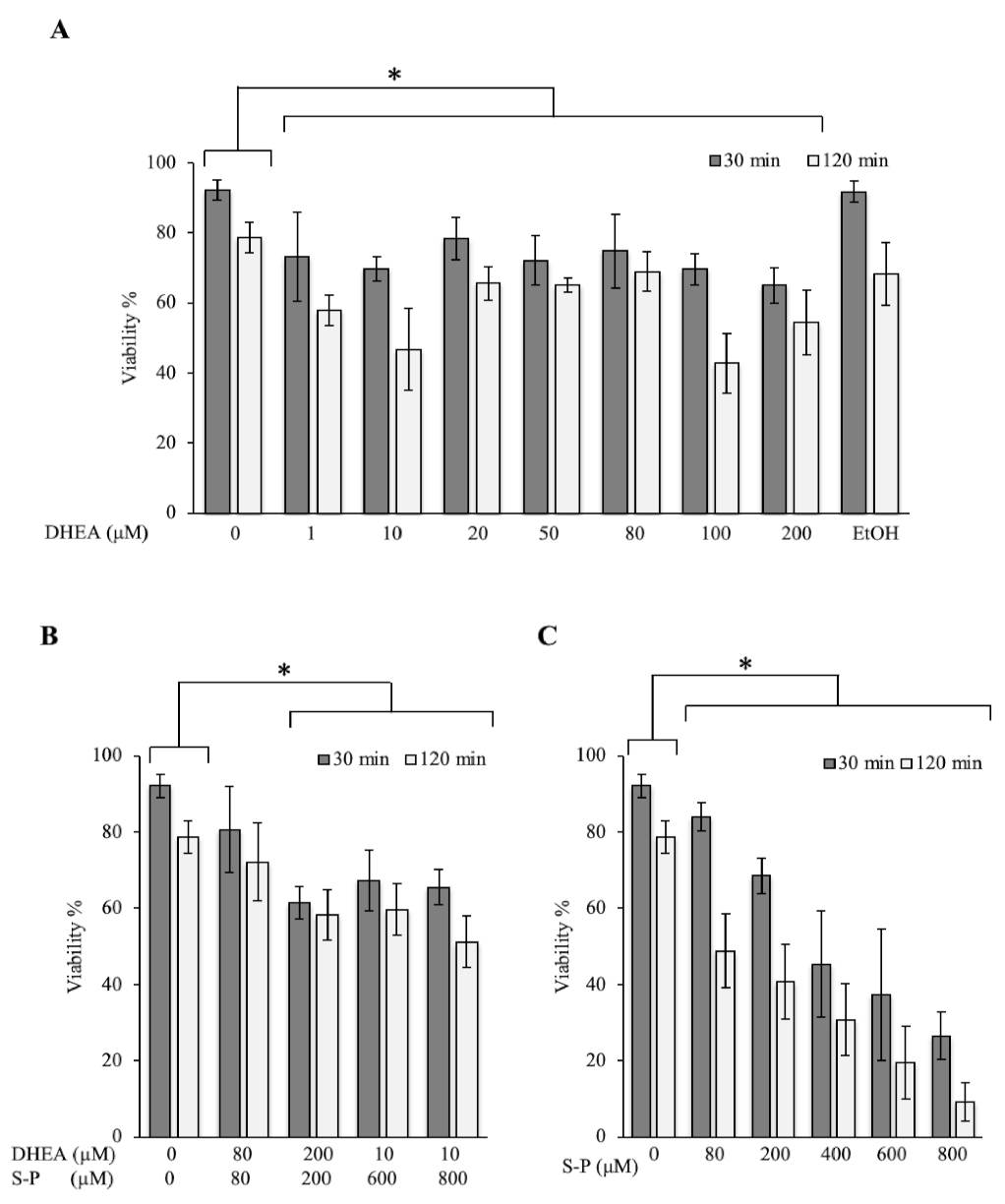
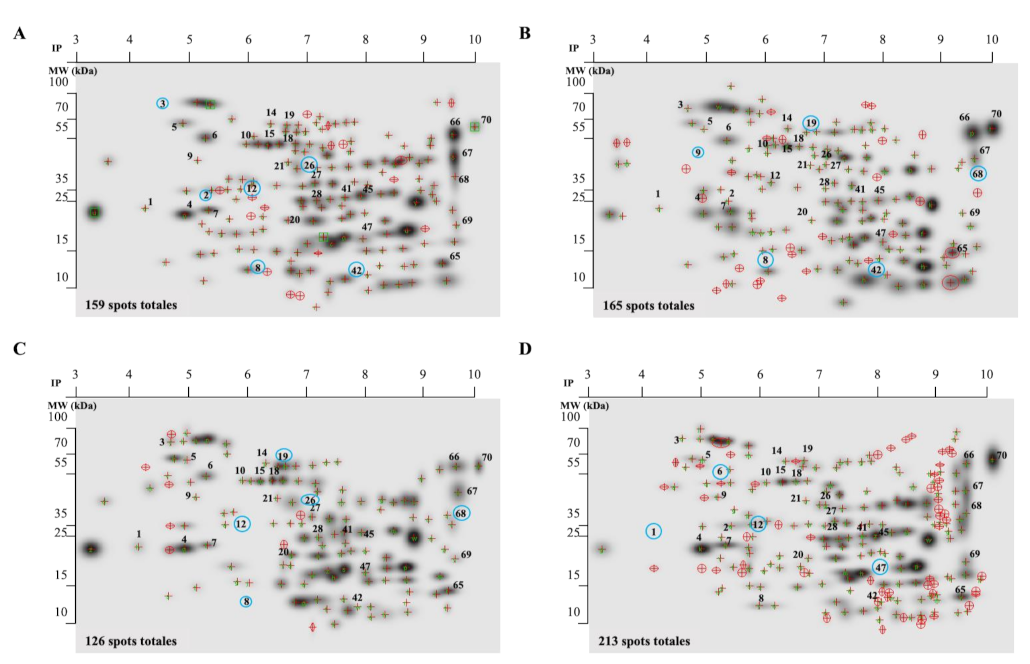
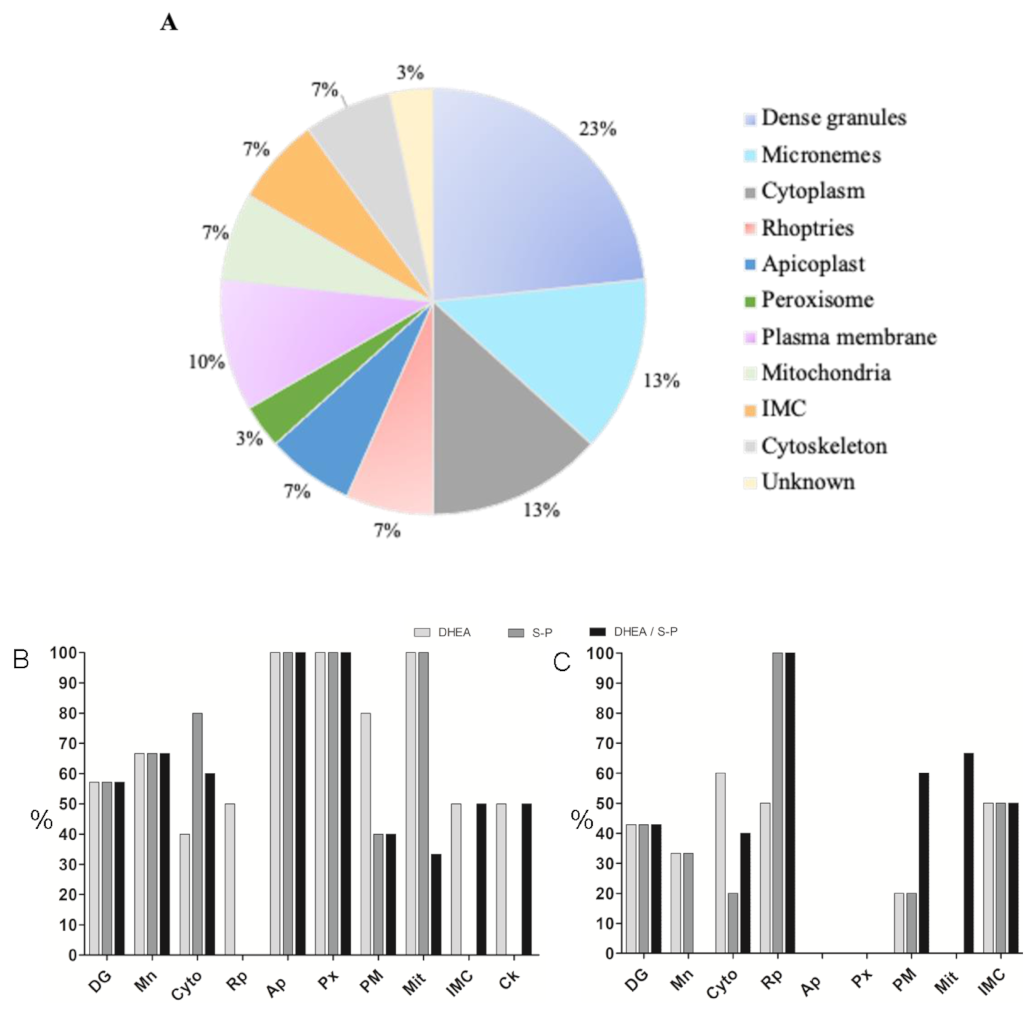
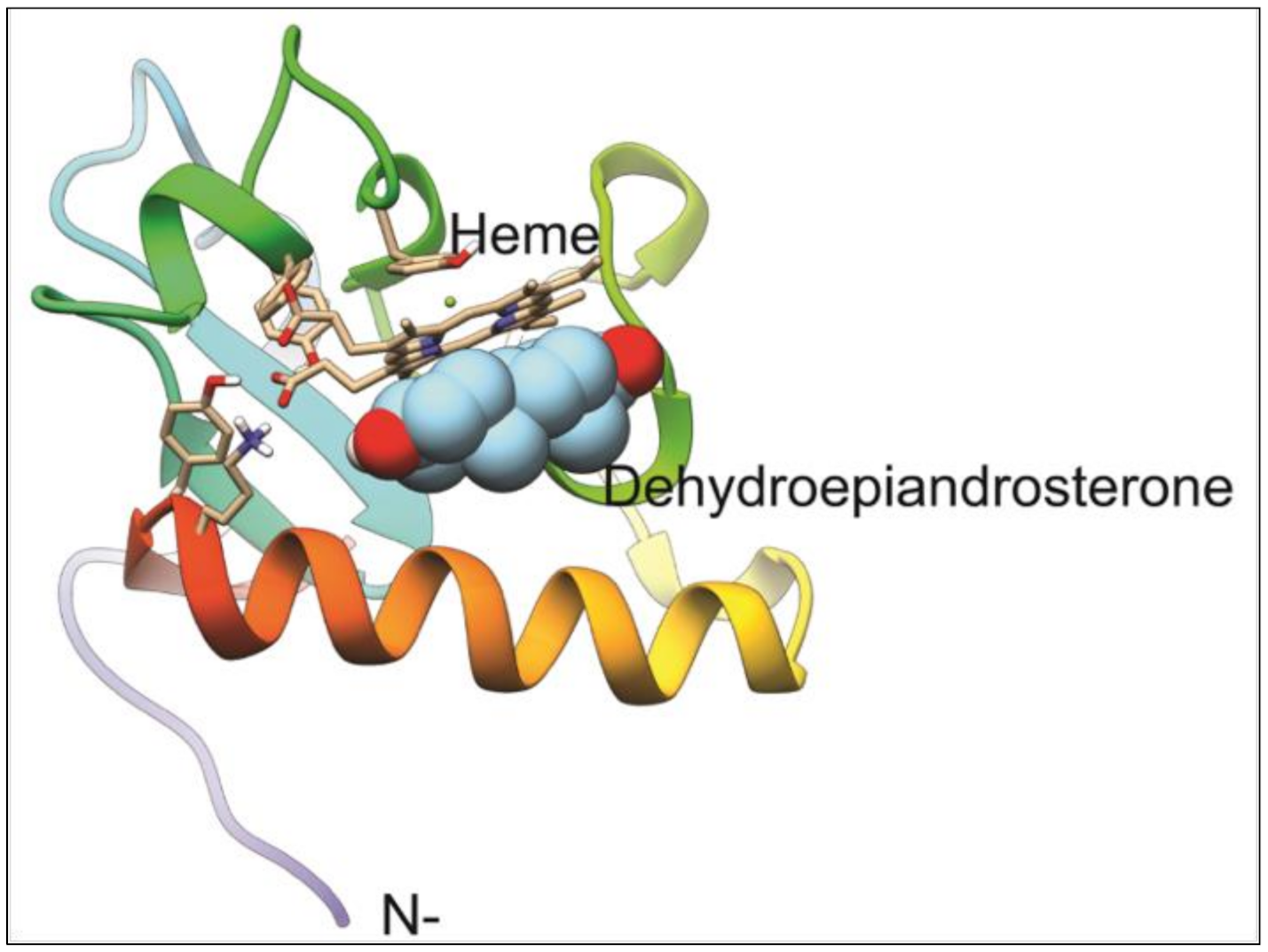
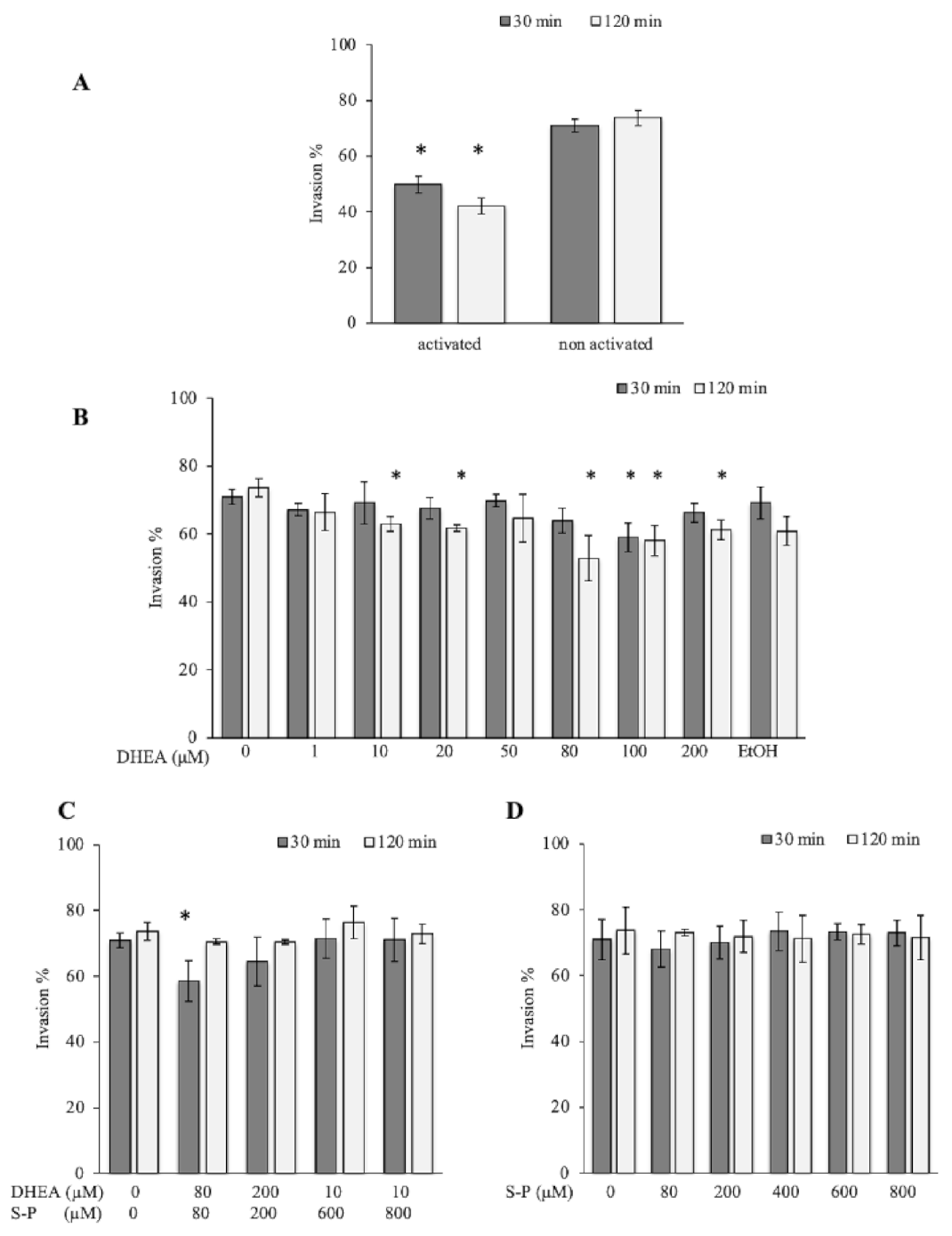

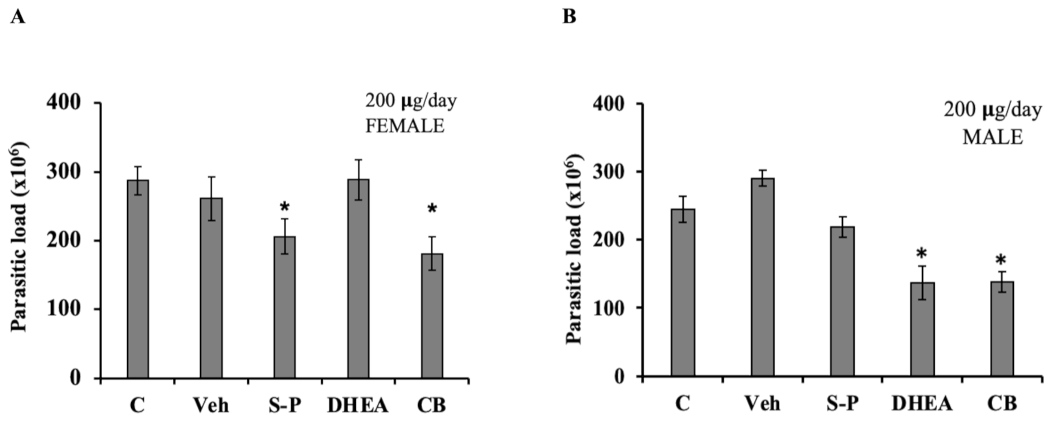
| Spot | Protein Name | Uniprot KB ID | Theoretical Mr/IP | Experimental Mr/IP | Possible Location | Percentage of Expression | |||
|---|---|---|---|---|---|---|---|---|---|
| Ctrl | DHEA | S-P | DHEA/S-P | ||||||
| 1 | Dense granule protein (GRA1) | P13403 | 17.85/4.13 | 23/4.1 | DG | 100 | 103.43 | 116.11 | _ |
| 2 | Cytochrome b5 family heme/steroid binding domain-containing protein | A0A139XPA0 | 26.25/5.18 | 27/5.1 | Unk | _ | 100.00 | _ | 101.72 |
| 3 | Microneme protein (MIC2) | O00816 | 82.61/4.45 | 84/4.5 | Mn | 100 | 100.00 | 89.70 | - |
| 4 | Dense granule protein (GRA7) | O00933 | 23.23/4.95 | 22.9/4.9 | DG | 100 | 96.20 | 100.58 | 108.56 |
| 5 | Microneme protein (MIC4) | Q9XZH7 | 63.02/4.84 | 63/4.66 | Mn | 100 | 102.02 | 100.16 | 86.91 |
| 6 | Micronemal protein (MIC1) | O00834 | 46.97/5.20 | 52.7/5.15 | Mn | 100 | 111.72 | 80.88 | - |
| 7 | Dense granule protein (GRA6) | Q27003 | 24.02/5.47 | 23.5/5.35 | DG | 100 | 111.37 | 83.77 | 100.28 |
| 8 | Dense granule protein (GRA5) | Q07828 | 12.97/5.81 | 12.5/5.98 | DG | 100 | 111.56 | - | 87.52 |
| 9 | Rhoptry protein (ROP1) | A0A125YP48 | 47.99/4.9 | 45/4.99 | Rh | 100 | - | 95.47 | 84.69 |
| 10 | Enolase 2 | Q9BPL7 | 48.29/5.67 | 53/5.71 | Cp | 100 | 97.69 | 77.87 | 82.51 |
| 12 | Inosine-5′-monophosphate dehydrogenase | Q4VRV8 | 40.36/6.08 | 38.5/6.01 | Cp | 100 | 97.69 | _ | _ |
| 14 | Rhoptry neck protein (RON4) | B6KJ32 | 65.34/6.49 | 65.8/6.41 | Rh | 100 | 103.18 | 93.99 | 87.09 |
| 15 | Anamorsin homolog | B9Q0C2 | 47.56/6.49 | 53/6.38 | Cp | 100 | 80.32 | 67.19 | 73.99 |
| 18 | Elongation factor Tu | Q9TMM9 | 44.31/6.52 | 52/6.5 | Api | 100 | 67.93 | 79.73 | 58.40 |
| 19 | Peroxisomal catalase | Q9XZD5 | 57.27/6.71 | 63/6.69 | Pxs | 100 | _ | _ | 80.09 |
| 20 | Profilin | A0A086PNN0 | 20.78/6.51 | 21/6.7 | Ck | 100 | 73.04 | 105.30 | 70.61 |
| 21 | Gliding associated protein (GAP40) | E0AE39 | 43.08/6.61 | 44/6.6 | IMC | 100 | 96.97 | 97.93 | 82.98 |
| 26 | Acid phosphatase GAP50 | A0A086PXK7 | 46.60/6.95 | 46/6.97 | IMC | 100 | 100.00 | _ | 74.67 |
| 27 | Dense granule protein (GRA4) | Q27002 | 34.08/7.19 | 36.5/7.12 | DG | 100 | 67.36 | 67.59 | 62.95 |
| 28 | Major surface antigen p30 (SAG1) | P13664 | 29.80/6.84 | 26/7.1 | PM | 100 | 72.51 | 68.20 | 63.38 |
| 41 | Rhomboid-like protease (ROM1) | Q695U0 | 32.83/7.69 | 30/7.68 | Mn | 100 | 76.65 | 100.82 | 90.53 |
| 42 | Actin depolymerizing factor (ADF) | A0A086PI60 | 12.94/7.92 | 12.5/7.8 | Ck | 100 | _ | 100.00 | 93.97 |
| 45 | Rhomboid-like protease (ROM3) | Q6IUY1 | 29.34/8.19 | 30/7.95 | PM | 100 | 79.51 | 76.99 | 104.23 |
| 47 | Dense granule protein (GRA2) | P13404 | 17.46/8.21 | 17/8.0 | DG | 100 | 95.42 | 94.06 | _ |
| 65 | 50S ribosomal protein L14 | Q9XQQ6 | 14.08/9.77 | 13.9/9.4 | Api | 100 | 102.35 | 90.08 | 91.17 |
| 66 | Rhomboid-like protease (ROM4) | Q695T8 | 69.66/9.24 | 65.5/9.51 | PM | 100 | 93.25 | 78.85 | 90.41 |
| 67 | Cytochrome b | O20672 | 41.59/9.25 | 46.5/9.51 | Mit | 100 | 78.58 | 86.36 | 88.36 |
| 68 | Phosphatidylserine decarboxylase proenzyme 1 | Q1PCQ8 | 39.44/9.61 | 39/9.61 | Mit | 100 | _ | _ | 97.36 |
| 69 | Dense granule protein (GRA3) | B6KEU8 | 24.24/9.46 | 20/9.65 | DG | 100 | 103.72 | 100.15 | 110.65 |
| 70 | Diacylglycerol kinase catalytic domain-containing protein | A0A139XS45 | 69.58/10.02 | 63/9.97 | Cp | 100 | 145.63 | 97.38 | 136.91 |
| Predicted Ligand | Theoretical Affinity(kcal/mol) |
|---|---|
| 4–5 alpha-Dihydrotestosterone | −7.4 |
| Aldosterone | −7.1 |
| Beta-estradiol | −6.7 |
| Cholesterol | −6.6 |
| Corticosterone | −6.8 |
| Cortisol | −6.5 |
| Decanoate | −4.4 |
| DHEA | −7.4 |
| Dodecanoate | −4.6 |
| Estriol | −7.2 |
| Linoleate | −5.5 |
| Myristate | −5 |
| Octanoate | −4.1 |
| Oleate | −5.4 |
| Palmitate | −4.6 |
| Progesterone | −7.6 |
| Pyrimethamine | −5.9 * |
| Stearic | −5.1 |
| Sulfadiazine | −5.5 * |
| Testosterone | −7.4 |
| Experimental Assays | DHEA | S-P | DHEA/S-P |
|---|---|---|---|
| In vitro viability Inhibition (%) | |||
| 15–30%, 30 min | 25–72%, 30 min | 25–40% 30 and 120 min | |
| 13–50%, 120 min | >50%, 120 min | ||
| Proteomic profile | |||
| Total number of spots | 165 | 126 | 213 |
| Number of spots that changed | 65 | 27 | 100 |
| Protein expression (N = 30) | |||
| Overexpressed proteins | 9 | 5 | 4 |
| Subexpressed proteins | 12 | 16 | 18 |
| Absent proteins | 4 | 7 | 5 |
| Unchanged proteins | 3 | 5 | 3 |
| Particular protein expressed | Cytochrome b5 family heme/steroid binding domain-containing protein | Cytochrome b5 family heme/steroid binding domain-containing protein | |
| BLAST analysis | PGRMC homologue | PGRMC homologue | |
| In vitro Passive invasion | |||
| Inhibition (%) | <6%, 30 min | No inhibition | ≈12% |
| 15–30%, 120 min | ≈30% | ||
| Morphological Changes | Lost typical half-moon shape, intracellular organization, and the apical polarity. | Tachyzoites exhibited an ameboid, elongated, or amorphous shape. Lost apical polarity and organelle organization. | Lost typical shape, intracellular organelle organization and polarity. Presence of amylopectin granules and/or empty cytoplasmic vacuole. |
| In Vivo treatmentPercent of reduction in peritoneal parasite load | |||
| Female mice | 0% | ≈28% | ~37% |
| Male mice | 45% | 0% | 44% |
Publisher’s Note: MDPI stays neutral with regard to jurisdictional claims in published maps and institutional affiliations. |
© 2021 by the authors. Licensee MDPI, Basel, Switzerland. This article is an open access article distributed under the terms and conditions of the Creative Commons Attribution (CC BY) license (http://creativecommons.org/licenses/by/4.0/).
Share and Cite
Muñiz-Hernández, S.; Luna-Nophal, A.; León, C.T.G.-D.; Domínguez-Ramírez, L.; Patrón-Soberano, O.A.; Nava-Castro, K.E.; Ostoa-Saloma, P.; Morales-Montor, J. Dehydroepiandrosterone Effect on Toxoplasma gondii: Molecular Mechanisms Associated to Parasite Death. Microorganisms 2021, 9, 513. https://doi.org/10.3390/microorganisms9030513
Muñiz-Hernández S, Luna-Nophal A, León CTG-D, Domínguez-Ramírez L, Patrón-Soberano OA, Nava-Castro KE, Ostoa-Saloma P, Morales-Montor J. Dehydroepiandrosterone Effect on Toxoplasma gondii: Molecular Mechanisms Associated to Parasite Death. Microorganisms. 2021; 9(3):513. https://doi.org/10.3390/microorganisms9030513
Chicago/Turabian StyleMuñiz-Hernández, Saé, Angélica Luna-Nophal, Carmen T. Gómez-De León, Lenin Domínguez-Ramírez, Olga A. Patrón-Soberano, Karen E. Nava-Castro, Pedro Ostoa-Saloma, and Jorge Morales-Montor. 2021. "Dehydroepiandrosterone Effect on Toxoplasma gondii: Molecular Mechanisms Associated to Parasite Death" Microorganisms 9, no. 3: 513. https://doi.org/10.3390/microorganisms9030513
APA StyleMuñiz-Hernández, S., Luna-Nophal, A., León, C. T. G.-D., Domínguez-Ramírez, L., Patrón-Soberano, O. A., Nava-Castro, K. E., Ostoa-Saloma, P., & Morales-Montor, J. (2021). Dehydroepiandrosterone Effect on Toxoplasma gondii: Molecular Mechanisms Associated to Parasite Death. Microorganisms, 9(3), 513. https://doi.org/10.3390/microorganisms9030513






